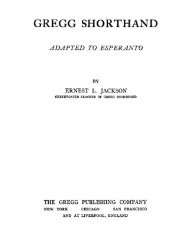GREGG SHORTHAND DICTIONARY
GREGG SHORTHAND DICTIONARY
GREGG SHORTHAND DICTIONARY
Create successful ePaper yourself
Turn your PDF publications into a flip-book with our unique Google optimized e-Paper software.
<strong>GREGG</strong> <strong>SHORTHAND</strong> <strong>DICTIONARY</strong> v<br />
First, we should explain that the following have been eliminated as being<br />
unnecessary :<br />
1. Short, simple words that any student who is still working on the early<br />
part of the Manual can easily write, such words as cat,dog, etc.<br />
2. Purely "dictionary words." Every word in the list of nearly 19,000<br />
is a word in good usage. If any of the words seem unfamiliar to you, however,<br />
look them up in an ordinary English dictionary and jot down the definition in<br />
your shorthand dictionary.<br />
3. Certain derivatives that are formed in accordance with the rules given<br />
in the textbook, such as the numerous derivatives of the suffix u/ate, and some<br />
others. In order to save space and make room. for more root words, a complete<br />
table of these suffix derivatives is given in this Introduction. In case<br />
there should be doubt as to the correct writing of one of the derivatives, reference<br />
to this table will make the matter clear.<br />
The Gregg Shorthand Dictionary contains the following indiospensable<br />
features:<br />
1. A list of the 19,000 most frequently used words in the English language.<br />
The words for which the shorthand forms are immediately obvious<br />
have been omitted.<br />
2. Many past tenses, plurals, and other derivative forms that were not<br />
included in previous editions of the shorthand dictionary.<br />
3. Derivatives in every case grouped under the root word in easily accessible<br />
form. Since the root words in type project slightly beyond the margin<br />
of the type column. the finding of any word is greatly facilitated-it is necessary<br />
only to look down the comparatively small list of root words that stand<br />
out at the left of each column.<br />
4. Direct derivatives. and in some cases closely allied words. are listed<br />
under their root words. This has been done in order to emphasize the value of<br />
the analogical building of outlines, and also in the belief that the practice of<br />
a group of related outlines is more valuable than the practice of the isolated<br />
outlines. FOUR FREQUENTLY USED DERIVATIVES<br />
The four derivatives most frequently formed are the past tense, the plural.<br />
the negative. and the comparative and superlative degrees of adjectives.<br />
. THE PAST TENSE. It may be helpful to summarize and condense the rules<br />
given in the Manual for the formation of the past tense.



